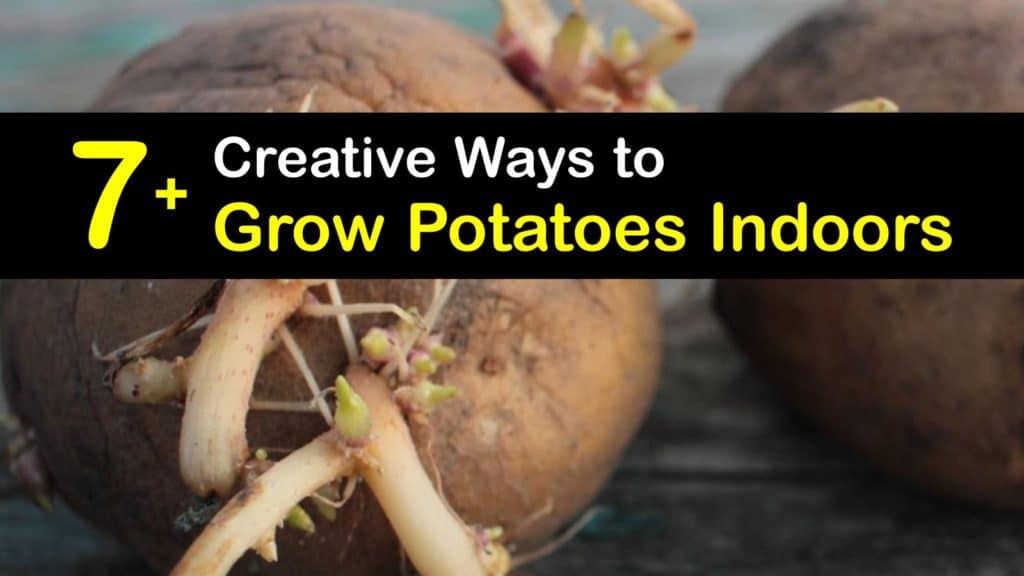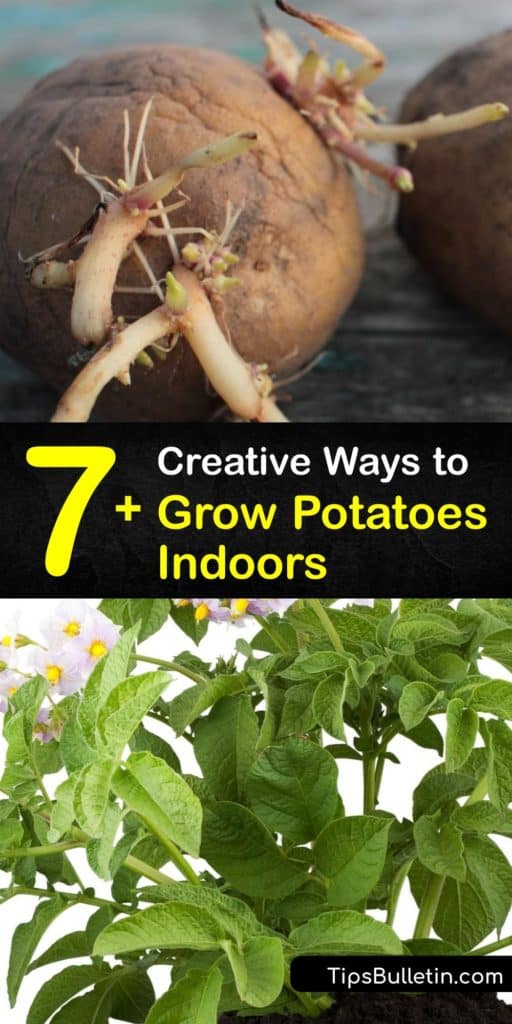If there were only a single crop you could grow on your property, potatoes would be one of the wisest choices. These crops are incredibly versatile and rich in protein, carbohydrates, vitamins, and nucleic acid. Find out how to grow potatoes indoors and use that knowledge to create filling dishes that won’t let your family go hungry.
Growing potatoes indoors is a cheap hobby with tremendous rewards. Have you ever taken a moment to think about all the recipes that involve potatoes? French fries, chips, mash, soups, casseroles, and stews are only some of the options.
What makes growing potatoes inside even more appealing is that it’s possible to grow new potatoes from old ones. If you’ve seen sprouted potatoes from the grocery store, those are new potato plants in action.

Types of Potatoes to Grow Inside
The first gardening step in learning how to grow potatoes indoors is choosing the type. Consider the use of each kind and how likely you are to cook with them. The most common store bought potatoes are russet, red potatoes, and fingerling potatoes.
Each of the best types of potatoes for tasty recipes has a different level of starch that cooks differently. Super starchy potatoes are best for absorbing liquid and turning it into a mash or fry.
Waxy potatoes, like new potatoes, are ideal for holding up in soups and stews. Regardless, there are a lot of spuds for you to try.
Even though it doesn’t matter where you live if you are growing potatoes indoors, it helps to know that most potatoes thrive in cool weather, especially if you prefer to move them outside from time to time.
An indoor potato plant is even better because you have control over the environment. Can you grow potatoes indoors without making a mess? Discover how amazingly easy it is to grow potatoes in a container indoors.
Try to choose heirloom cultivars that have a disease-free resistance built in. Even if you follow step by step instructions for growing potatoes inside, there is some basic knowledge that is beneficial. Planting potatoes is done in a few different ways, inside or out, whether you plant potatoes in straw or a big bucket.

Planting seed potatoes is the first option. These include tubers you can buy at a nursery or purchase online. Seed potatoes are a result of the previous year’s harvest.
Chitting is another process that encourages the plants to start sprouting and maturing before they are planted in the ground. Chitting isn’t necessary, but it does give you a head start on the growing season and helps larger potatoes mature faster.
Planting potatoes also means that you must have a good understanding of the basic care needs of these crops. Organic potatoes start to grow in the early spring, usually around five weeks before the last frost date.
They require soil temperatures of at least 45°F to germinate. As they grow, increase the temperature to 75°F. Give all indoor plants at least six hours of sunlight.
This lighting is easier to achieve when you have grow lights in the house or at least a sunny spot for them to reside. Plant potatoes in potting soil and amend the potting mix throughout the season with organic fertilizer for high yields.
Use slightly acidic soil with a pH level of 5.4 to 5.9. These requirements do not apply to all houseplants, so make sure you only raise potato plants this way.
How to Grow Potatoes Indoors
Many people don’t believe it when they learn that it’s not necessary to have an outdoor plot when growing potatoes. Planting sweet potatoes in containers is just as easy as growing them outside.
There are some very interesting ways to help these plants mature that you may not have heard of. Whenever possible, use a hilling method that keeps the water from sitting around the stem.
Growing Potatoes Indoors with Grow Bags
Is it possible to grow potato plants inside of a bag? It sure is! Grow bags are designed to help you develop a variety of vegetables without any land.
If grow bags are too expensive, any other large, cheap bag is acceptable. Some go-to options are burlap sacks or paper bags.
Add a few inches of soil and mulch to the bottom of the grow bag. Seed potato spacing is important. Plant three or four seed potatoes on top of the soil with the cut side facing down. Cover the potatoes with three more inches of soil and water them. Keep the soil moist as they grow.
When the seedlings start to rise, add more soil to the bags with the dirt mounded around the stem. There’s no need for drainage holes since the bags allow the water to drain. When you are ready to harvest them, turn the bag over and gently dump out the contents.
Growing Potatoes in Wire Cages
One of the more creative ways to grow potatoes inside is to use a wire cage. Find a designated area for your plants. Buy some quarter-inch mesh and secure it in a round position. The wire cage should be 18 inches wide and 24 inches tall.
Add a few inches of soil to the bottom. Plant three seed potatoes and cover them with three more inches of dirt. Water the potatoes regularly and mound more soil as they grow. Lift the cylinder when ready to harvest and shake off the dirt inside.
Growing Potatoes Inside Wooden Boxes
If you have some extra lumber lying around, create a makeshift raised bed that can sit anywhere in your house. If you prefer, add some wheels to the bottom to make it easy to move. Fill the box halfway with rich soil, plant the seed potatoes, and nurture them until maturity.
Using Straw to Plant Potatoes
One of the downsides of figuring out how to grow potatoes indoors is that the dirt makes a mess. Use less of it by replacing it with straw mulch.
Follow the same guidelines for potato planting that you’ve already learned, but cover them with seed-free straw instead. Continue to mound the straw throughout the growing season until there is a 12-inch layer and they are ready for harvesting.
Trash Can Potatoes
There is a lot more use from a trash can than you’d think. These barrels are easy to move around and the perfect container for growing potatoes inside. Growing potatoes in buckets is just as feasible.
This growing option is ideal for people who enjoy repurposing old items lying around the house. They aren’t only suitable for potatoes, either. Use these bins for any vegetable that you’d normally plant in a container garden.
Starting Potatoes in Egg Cartons
One of the trickiest facets of the entire potato-growing process is starting them. An egg carton is a perfect solution for chitting your potatoes or for planting potatoes vs turnips or carrots.
Place sprouting potato pieces in each spot with the sprouts growing upward. Keep the containers in a cool, bright place to encourage sturdy shoots.
Using Laundry Baskets to Plant Potatoes
If growing potatoes inside, you may as well use items you already have in a variety of ways. A laundry basket is a perfect solution for planting potatoes.
They are portable and allow you to move them to different areas of the house throughout the day. Make sure to drill good-sized drainage holes in the bottom to keep plants from rotting.
Sprout Potatoes in Water
All you need to get a grocery store potato to start sprouting is a glass of water and some toothpicks. Set a potato in a dark place until it starts producing shoots. How long does it take for potatoes to sprout? After about two weeks, cut off the shoot with a small piece of potato attached.
Place three toothpicks in a triangle formation around the potato and set it over a glass of water with the bottom part touching the water. Replace the water every couple of days until hardy sprouts form.
Watch for potato mold. If your potato develops bad spots, throw it out and start over. Transplant a sprouted potato into a container filled with rich soil.
The Biggest Potato Problem
Potatoes don’t have many issues, especially when grown indoors. However, scab is one of the common potato diseases you want to keep an eye on.
Scab is a tuber disease that makes plants turn yellow. It won’t kill the plant, but it drastically reduces your yield. Make sure you only work with sterile tools and never plant potatoes in the same soil or space as you did the year before.
A Potato Dish You Can’t Resist
You never know how big or small your indoor potatoes are going to be. The best recipe for this type of gardening is a simple roasted potatoes side dish.
Wash the outer skin of your potatoes. Peel them if they have thick skin that you prefer not to eat. Dice the potatoes into one-inch pieces.
Toss the potatoes in some oil with salt, pepper, paprika, garlic, and any other spices you enjoy. Roast the potatoes at 425°F for about 15 to 25 minutes until they are tender.
Potatoes are more versatile than almost any other veggie. There are endless ways to work with these crops and their starchy flavor pairs well with almost all other ingredients.
Unfortunately, not everyone has the means to grow these plants outside. Moving things indoors inspires you to get creative and work with plants in ways you never have before.

If learning how to grow potatoes indoors has opened your eyes to a new way of container gardening, share these methods of growing potatoes inside on Facebook and Pinterest.